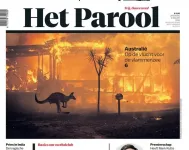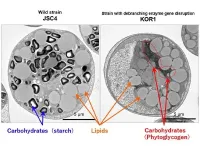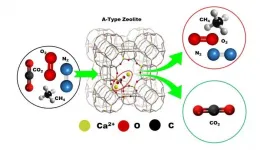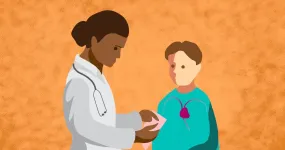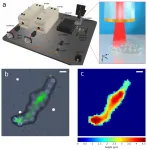(Press-News.org) Australia's 'black summer' of bushfires was depicted on the front pages of the world's media with images of wildlife and habitat destruction, caused by climate change, while in Australia the toll on ordinary people remained the visual front-page focus.
QUT visual communication researcher Dr TJ Thomson compared the front-page bushfire imagery of the Sydney Morning Herald over three months from November 10, 2019 to January 31 2020 with 119 front pages from international media from the start of January, when the world sat up and took notice, to January 31.
"The international sample of front pages included the Americas and Europe (about 90 per cent) representing Australia's 'black summer'. Asia represented around 7 per cent of the international sample and Oceania, excluding Australia, represented 3.3 percent of the sample."
"Over the 83 days of the sample, 33 of the Sydney Morning Herald's front pages displayed 58 photos that were bushfire-related," Dr Thomson said.
"The domestic media's imagery portrayed the bushfires as a humanitarian crisis while overseas it was seen as an environmental crisis.
"Visual news values include impact, aesthetic appeal, proximity and personalisation which includes, events with personal angles or human presence.
"More than 80 per cent of the Herald's coverage depicted people which relied on the personalisation news value.
"The Herald focussed most heavily on firefighters in nature (36.2 per cent of all front-page images and followed this closely with images of ordinary citizens and the effect of the fires on them (32.7 per cent, in all).
"Noticeably absent were images of the affected animals and the environment which were rather sparsely represented."
Dr Thomson said that while media could not control how people interpreted situations, the media could limit the range of interpretation by controlling the information it presented and the way in which it was represented.
"By focussing on people, particularly firefighters, the Herald depicted the disaster not as a faceless calamity but as a crisis whose solution was in human hands," he said.
"The low prevalence of politicians, officials and celebrities (13.7 per cent) in the domestic sample reflects the Australian news media's power to shape the discourse and portray the issue as one that affected ordinary Australians the most.
"It was less of a political issue, despite Prime Minister Scott Morrison being criticised for going on holiday in the midst of the crisis, the government's pro-coal policies, or the ignored warnings of a lack of preparedness for a major bushfire season as far back as April 2019.
Dr Thomson said the environment alone was featured in only nine images on the Herald's front pages and animals ("a solitary koala") made a single image appearance.
In contrast, Australia's bushfires hit the international media in earnest after the evacuation by the Navy of 1000 fire-stranded people from the beach in Victoria in early January and continued to January 31 with 110 front pages containing 142 bushfire-related images.
"An Australian photographer interviewed for the study said the international media hadn't taken any interest in the bushfires until people were having to be rescued from the beach - 'that was the day it went from a big national story to a massive, international story'".
"Our near neighbours, New Zealand, featured pics of their orange and smoky skies."
Dr Thomson found the most resonant photo internationally was the aerial image of this massive smoke tower rising from East Gippsland, which featured on 17 front pages.
"International media's images focused on the fires' impacts on the country's iconic flora and fauna, as 52.1 per cent of all coverage was devoid of humans and depicted only bushfire-affected landscapes or animals.
"They used high-intensity, large-in-scope images of Australia's woes as a warning to their populations to slow or halt climate change's deadly effects.
"By not focussing on the attributes that divide us (skin colour, ability, class, gender) images of the destruction of the natural environment and Australian animal icons were prime targets for symbolic appropriation to a diverse and heterogenous audience because of their universality.
"From kangaroos and koalas to cattle and alpacas, international outlets featured animals more than 10 times as much as the Australian front pages.
"While kangaroos and koalas are iconic animals and symbols of Australia, they were over-represented in coverage despite not being the most affected animals, as mammals accounted only for an estimated 143 million (4.7 percent) out of the three billion animals lost in the fires.
"This image won a World Press Photo Award and represents Australia's black summer if not climate change itself.
"It also lacks people but the letterbox and burning home make the human presence unmistakable. It was republished across media over time and used extensively in social media, including being posted by teenage climate activist Greta Thunberg to her millions of followers."
Dr Thomson said about 10 per cent of international coverage was critical of Australia's government for its role in the factors that contributed to the mega fires or in its handling of them.
"About 6.7 per cent of those criticised the Prime Minister by name or by title. The remaining 3.3 per cent criticised the country's government or its political leaders for their role in the disaster and its management," he said.
"For example, the Tampa Bay Times' front page on 3 January 2020 wrote: "As record flames and devastation batter Australia, residents turn their anger on the prime minister and his policies. At least 17 people have died."
INFORMATION:
Picturing destruction at home and abroad: a comparative visual analysis of icons and news values during disaster was published in Media International Australia.
Media contact: Rod Chester, QUT Media, 07 3138 9449, rod.chester@qut.edu.au After hours: Rose Trapnell, 0407 585 901, media@qut.edu.au
Transitioning from fossil fuels to a clean hydrogen economy will require cheaper and more efficient ways to use renewable sources of electricity to break water into hydrogen and oxygen.
But a key step in that process, known as the oxygen evolution reaction or OER, has proven to be a bottleneck. Today it's only about 75% efficient, and the precious metal catalysts used to accelerate the reaction, like platinum and iridium, are rare and expensive.
Now an international team led by scientists at Stanford University and the Department of Energy's SLAC National Accelerator Laboratory has developed a ...
A cross-institutional collaboration has developed a technique to repartition carbon resources from carbohydrates to lipids in microalgae. It is hoped that this method can be applied to biofuel production. This discovery was the result of a collaboration between a research group at Kobe University's Engineering Biology Research Center consisting of Project Assistant Professor KATO Yuichi and Professor HASUNUMA Tomohisa et al., and Senior Researcher SATOH Katsuya et al. at the Takasaki Advanced Radiation Research Institute of the Quantum Beam Science Research Directorate ...
Scientists are calling for more stringent pesticide bans to lower deaths caused by deliberately ingesting toxic agricultural chemicals, which account for one fifth of global suicides.
A NHMRC funded study, in which the University of South Australia analysed the patient plasma pesticide concentrations, has identified discrepancies in World Health Organization (WHO) classifications of pesticide hazards that are based on animal doses rather than human data.
As a result, up to five potentially lethal pesticides are still being used in developing countries in the Asia Pacific, where self-poisonings account for up to two thirds of suicides.
In ...
New research from the University of Virginia School of Medicine reveals why sleep can put people with epilepsy at increased risk of sudden death.
Both sleep and seizures work together to slow the heart rate, the researchers found. Seizures also disrupt the body's natural regulation of sleep-related changes. Together, in some instances, this can prove deadly, causing Sudden Unexpected Death in Epilepsy, or SUDEP.
"We have been trying to better understand the cardiac changes around the time of a seizure in patients with epilepsy. When we looked ...
Proteins are the workhorses of cells, responsible for almost all biological functions that make life possible.
Understanding how specific proteins work is key to disease prevention and treatment, allowing us to lead longer, healthier lives.
Yet scientists still know nothing or very little about thousands of proteins that exist in our bodies and their role in keeping us alive.
Now researchers from Xi'an Jiaotong-Liverpool University have uncovered a new protein analysis tool - coined the Bacterial Growth Inhibition Screen (BGIS) - that could fast-track the process of assessing proteins. The tool allows for quick and efficient basic characterisation of protein function with no special equipment or cost involved.
Dr Ferdinand Kappes of XJTLU's ...
It is now well known that carbon dioxide is the biggest contributor to climate change and originates primarily from burning of fossil fuels. While there are ongoing efforts around the world to end our dependence on fossil fuels as energy sources, the promise of green energy still lies in the future. Can something be done in the meantime to reduce the concentrations of CO2 in the atmosphere?
It would, in fact, be great if the CO2 in the atmosphere could simply be adsorbed! Turns out, this is exactly what direct air capture (DAC), or the capture of CO2 under ambient conditions, aims to do. However, no such material with the ability to adsorb CO2 efficiently under DAC ...
In Alzheimer's disease, neurons in the brain die. Largely responsible for the death of neurons are certain protein deposits in the brains of affected individuals: So-called beta-amyloid proteins, which form clumps (plaques) between neurons, and tau proteins, which stick together the inside of neurons. The causes of these deposits are as yet unclear. In addition, a rapidly progressive atrophy, i.e. a shrinking of the brain volume, can be observed in affected persons. Alzheimer's symptoms such as memory loss, disorientation, agitation and challenging behavior are the consequences.
Scientists at the DZNE led by Prof. Michael Wagner, head of a research group at the DZNE and senior ...
Determining safe yet effective drug dosages for children is an ongoing challenge for pharmaceutical companies and medical doctors alike. A new drug is usually first tested on adults, and results from these trials are used to select doses for pediatric trials. The underlying assumption is typically that children are like adults, just smaller, which often holds true, but may also overlook differences that arise from the fact that children's organs are still developing.
Compounding the problem, pediatric trials don't always shed light on other differences that can affect recommendations for drug doses. There are many factors that limit children's participation in drug trials - for instance, some diseases simply ...
AURORA, Colo. (May 6, 2021) - Scientists examining the remains of 36 bubonic plague victims from a 16th century mass grave in Germany have found the first evidence that evolutionary adaptive processes, driven by the disease, may have conferred immunity on later generations of people from the region.
"We found that innate immune markers increased in frequency in modern people from the town compared to plague victims," said the study's joint-senior author Paul Norman, PhD, associate professor in the Division of Personalized Medicine at the University of Colorado School of Medicine. "This suggests these markers might have evolved to resist the plague."
The study, done in conjunction with the Max Planck Institute in Germany, was published online Thursday in the journal Molecular ...
Ultrasound is an indispensable tool for the life sciences and various industrial applications due to its non-destructive, high contrast, and high resolution qualities. A persistent challenge over the years has been how to increase the resolution of an acoustic endoscope without drastically increasing the footprint of the probe, or risking the robustness of the ultrasonic transducer. In recent years, a host of all-optical ultrasonic imaging techniques have emerged - which generally utilise pulsed lasers and optical cavities to excite and detect ultrasound waves - without sacrificing device footprint, sensitivity, or the integrity of the transducer. Thus far these powerful techniques have achieved imaging resolutions on microscopic-mesoscopic length ...
